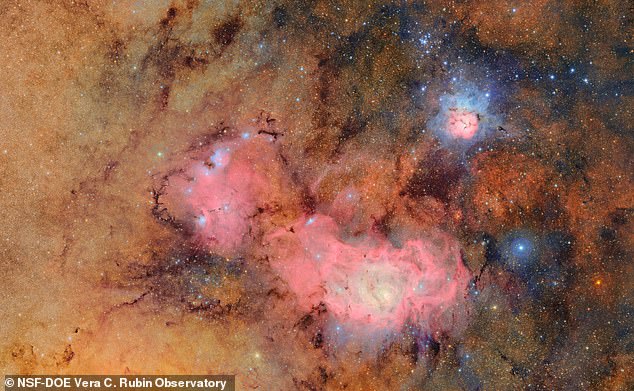
Vera Rubin Observatory’s Giant Camera Unveils Trifid and Lagoon Nebulae in Stunning Debut Image
World’s Largest Camera Unveils Stunning Cosmic Views
The Vera C. Rubin Observatory, perched atop Chile’s Cerro Pachón mountain, has released its first images from the largest digital camera ever built. Designed to revolutionize astronomy, this groundbreaking telescope boasts a 3,200-megapixel camera—67 times more powerful than an iPhone 16 Pro—capable of capturing a sky area three times the size of the Moon in a single shot. Each image requires 400 4K TV screens to display at full resolution.
First Glimpses of the Cosmos
Among the inaugural photos is a mesmerizing view of the Trifid and Lagoon nebulae, vibrant gas clouds 9,000 light-years away. Combining 678 exposures over seven hours, the image reveals swirling blue and pink gases and newborn stars (Fig 1). Another test image showcases 10 million galaxies—just 0.5% of the 20 billion galaxies the observatory aims to study over its decade-long mission (Fig 2).
[Fig 1: Trifid (center) and Lagoon (top right) nebulae, 9,000 light-years away.]
[Fig 2: A dense galaxy cluster from Rubin’s test images.]
A Telescope Built for Discovery
At 8,770 feet elevation, the Chilean site offers minimal atmospheric interference, ideal for Rubin’s four core missions:
- Mapping celestial changes over time.
- Studying Milky Way formation.
- Charting solar system objects.
- Unveiling dark matter’s secrets.
Starting in 2025, Rubin will embark on the Legacy Survey of Space and Time (LSST), snapping a sky image every 40 seconds nightly. Over 10 years, it will map the southern sky every three days, compiling a “cosmic movie” of the universe’s evolution.
Data Deluge and Planetary Hunts
The telescope will generate tens of thousands of nightly images, aided by UK data centers processing the flood of information. Its rapid imaging can detect subtle changes, issuing up to 10 million alerts nightly for phenomena like supernovae, asteroid movements, or distant galaxy shifts. Scientists predict it could catalog 10 times more solar system objects, including the hypothetical Planet Nine, suspected to lurk beyond Neptune.
[Fig 3: Rubin’s camera, the largest ever built, during assembly.]
Engineering Marvel
Rubin’s three-mirror system directs light into its colossal camera, with precision so sharp that even a dust speck can distort images. The setup includes a 27.5-foot primary mirror and sensors sensitive enough to spot galaxies billions of light-years away. “Rubin is a discovery machine,” says Deputy Director Aaron Roodman. “It will reveal dim galaxies, stellar interactions, and solar mysteries unlike anything before.”
Honoring a Legacy
The observatory bears the name of astronomer Vera Rubin, who pioneered dark matter research in the 1970s. Her work revealed galaxies’ unexplained mass, implying invisible “dark matter” binds them—a puzzle Rubin’s namesake aims to unravel.
[Fig 4: Vera Rubin, whose dark matter research reshaped astrophysics.]
As Rubin Observatory prepares for its 2025 debut, these test images hint at a new era of cosmic exploration. With plans to livestream more findings soon, astronomers worldwide await a decade of unprecedented celestial insights.
Word count: ~600
Note: Image placeholders (Fig 1-4) correspond to original article visuals, described here for context.


